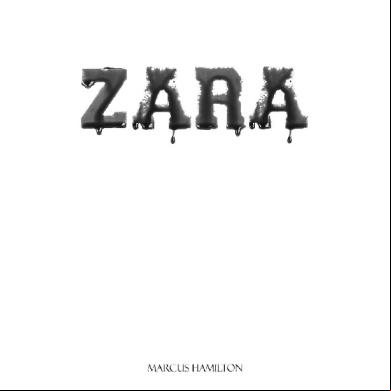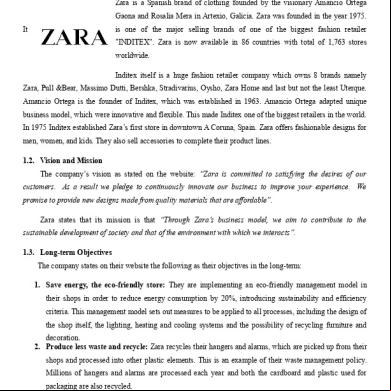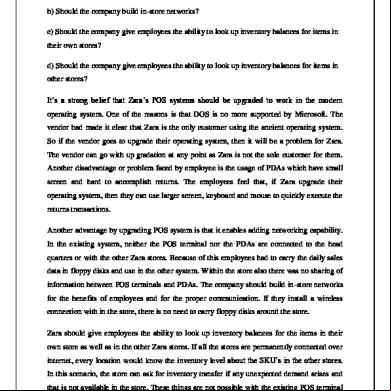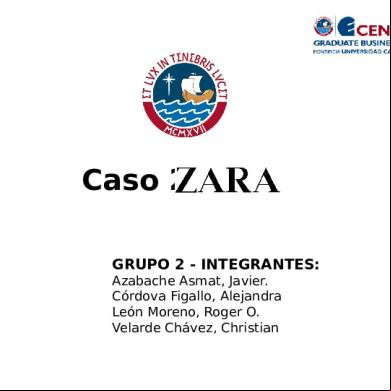Zara 371313
This document was ed by and they confirmed that they have the permission to share it. If you are author or own the copyright of this book, please report to us by using this report form. Report 3b7i
Overview 3e4r5l
& View Zara as PDF for free.
More details w3441
- Words: 444
- Pages: 15
Basic Facts • Inditex SA is the parent company of Zara. • Inditex offered a 23% stake to the public in 2001. • Zara contributes to 80% of group sales. • The Zara design team is in A Coruña. • Zaras most profitable store is in Regent Street, London.
• It is a vertically Integrated company. • 200 people -> 1000 new styles per month. • It follows “reacting” as apposed to “forecasting”. • Each store receives deliveries twice a week. • Zara spends only 0.3% of sales on advertising.
Some Additional Information • New collections are brought into the stores twice a week, and because there aren’t many of each item, it makes them seem “exclusive” unlike H&M that mass produces each item. • At the headquarters in Spain, sales of each piece are monitored, designers create new things according to the sales, and window displays are created on a mock storefront that is on a life-size street
During the sale
Referencing • ‘Spanish fast-fashion brand Zara's sales matches top brands in India, 18 more stores to come on soon’2013, The Economic Times, July 3. • ‘Retail rush at the malls: Sales zoom about 40% yo-y’ 2013, The Economic Times, July 9. • ‘Spain's Inditex opens first Zara store in India’ 2010, The Economic Times, May 31. • ‘Spanish retail brand Zara favourite among Indian shoppers’2011, The Economic Times, April 27.
ZARA SWOT ANALYSIS
ZARA STRENGTHS • • • • • • • • • • • • • • • •
Vertically Integrated Fast fashion Fast delivery Latest fashion trends Stores all over the world Strong distribution channels Accepts Deals with mostly the supply chain Clothes for men, women and children Low inventory assures items sell out quickly Point of sale system allows to monitor trends at each store Monitors fashion trends instead of guessing Inexpensive Saves time to market by not outsourcing manufacturing Minimalistic store image Environmental and animal welfare policies
ZARA WEAKNESSES
• • • • • • • • • • • •
No particular target market Plain clothes Low in-store inventory Centralized production Similar to H&M and other fast fashion stores Euro – cetric model Weak online presence Low advertising Bad quality Low communication Repeated sales Limitation on service
ZARA OPPERTUNITIES • • • •
Global fashion product Online markets Growth potential High demand for high fashion at affordable prices
ZARA THREATS • • • • • • • •
No advertising Higher price tag than the competition Conversion from Euro’s hurts global competitiveness Manufacturing base in Spain may become expensive High / close competition Economic downturn Imitation of goods Dilution of brand equity
Recommendations and Suggestions
• It is a vertically Integrated company. • 200 people -> 1000 new styles per month. • It follows “reacting” as apposed to “forecasting”. • Each store receives deliveries twice a week. • Zara spends only 0.3% of sales on advertising.
Some Additional Information • New collections are brought into the stores twice a week, and because there aren’t many of each item, it makes them seem “exclusive” unlike H&M that mass produces each item. • At the headquarters in Spain, sales of each piece are monitored, designers create new things according to the sales, and window displays are created on a mock storefront that is on a life-size street
During the sale
Referencing • ‘Spanish fast-fashion brand Zara's sales matches top brands in India, 18 more stores to come on soon’2013, The Economic Times, July 3. • ‘Retail rush at the malls: Sales zoom about 40% yo-y’ 2013, The Economic Times, July 9. • ‘Spain's Inditex opens first Zara store in India’ 2010, The Economic Times, May 31. • ‘Spanish retail brand Zara favourite among Indian shoppers’2011, The Economic Times, April 27.
ZARA SWOT ANALYSIS
ZARA STRENGTHS • • • • • • • • • • • • • • • •
Vertically Integrated Fast fashion Fast delivery Latest fashion trends Stores all over the world Strong distribution channels Accepts Deals with mostly the supply chain Clothes for men, women and children Low inventory assures items sell out quickly Point of sale system allows to monitor trends at each store Monitors fashion trends instead of guessing Inexpensive Saves time to market by not outsourcing manufacturing Minimalistic store image Environmental and animal welfare policies
ZARA WEAKNESSES
• • • • • • • • • • • •
No particular target market Plain clothes Low in-store inventory Centralized production Similar to H&M and other fast fashion stores Euro – cetric model Weak online presence Low advertising Bad quality Low communication Repeated sales Limitation on service
ZARA OPPERTUNITIES • • • •
Global fashion product Online markets Growth potential High demand for high fashion at affordable prices
ZARA THREATS • • • • • • • •
No advertising Higher price tag than the competition Conversion from Euro’s hurts global competitiveness Manufacturing base in Spain may become expensive High / close competition Economic downturn Imitation of goods Dilution of brand equity
Recommendations and Suggestions











